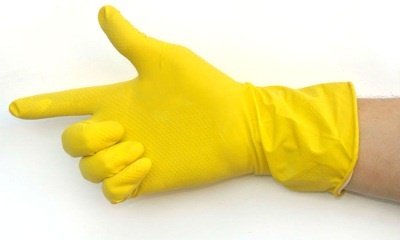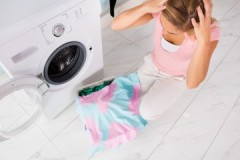Tips and tricks on how and at what temperature to wash satin by hand and in the washing machine
 In order for satin clothes and linen to serve as long as possible, not to fade, not to shrink, and the fabric does not lose its attractiveness and strength, it is necessary to adhere to some rules of care. They are pretty simple and easy to do if you want to.
In order for satin clothes and linen to serve as long as possible, not to fade, not to shrink, and the fabric does not lose its attractiveness and strength, it is necessary to adhere to some rules of care. They are pretty simple and easy to do if you want to.
How to wash satin in a washing machine and by hand, at what temperature, does the fabric shrink or not, we will tell in the article.
Content
Preparation for the process
First, here what should be the actions at the stage of preparing satin linen for washing:
 First of all, it is necessary to sort by color: white separately from color.
First of all, it is necessary to sort by color: white separately from color.- Duvet covers, pillowcases or other items should be turned inside out and fastened with all zippers and buttons, if any.
- Dry laundry should not occupy more than half of the drum of the washing machine: the fact is that satin, when wet, not only significantly gains weight, but also increases in size.
Leave more space in the drum to prevent the laundry from getting lumpy and rinsing well. Duvet covers that do not have a clasp would be wise to wash separately.
- To prevent friction during washing and possible destruction of fibers, it is not recommended to lay satin products together with synthetic ones (for example, from polyester, lavsan or microfiber). Or, you can put individual wardrobe items in colorless pillowcases or special protective nets before washing.
Washing instructions
Let's take a closer look at how to wash satin.
In a typewriter
The instructions for washing satin products in a regular washing machine are quite simple. However, it also has a number of nuances:
- The optimal temperature regime is considered to be in the range of 40-60C (there are preferences for various types of satin - this is best described by a sewn label with symbols containing basic instructions on each product).
-
 You can choose any gel, powder or capsule for the type of fabric or delicate wash (eg Synergetic, Eco Norland, BioMio, Garden). Products for baby linen are also suitable.
You can choose any gel, powder or capsule for the type of fabric or delicate wash (eg Synergetic, Eco Norland, BioMio, Garden). Products for baby linen are also suitable.It is not recommended to use powders or gels containing chlorine-based bleaching components (sodium hypochlorite) - such as "Whiteness", "Whiteness Plus", "AS", "AS Lemon", "Domestos".
Even if white linen is loaded into the machine, these agents will cause premature wear of the fabric due to the violation of the structure and strength of the threads.
- In order to make things soft after washing and have a pleasant aroma, it is allowed to use a conditioner (Lenor, Vernel, Eared nanny, etc.).
- Satin is not squeezed out at high speeds - 500-600 will be enough.
- In some cases, drying is possible - both by machine (at low thermal activity) and delicate wringing followed by drying in air. Of course, the owner makes the decision, but it is advisable to give preference to the second option.
By hands
This is the most gentle type of washing for satin items. The water temperature depends on the degree of pollution, however, in this case, one should not go beyond the above indicated limits (40-60C).
 Satin garments are soaked and hand washed separately, so this type of washing is suitable for small wardrobe items... Large items, such as bedding, are of course better suited for a machine.
Satin garments are soaked and hand washed separately, so this type of washing is suitable for small wardrobe items... Large items, such as bedding, are of course better suited for a machine.
For stubborn stains, use mild stain removers, white fabric can be treated with a sodium percarbonate bleach ("Oxi Stain Remover", "Persol").
After rinsing, it is wiser to let the water drain, and then hang the clothes on a line to dry... It is not allowed to boil satin things, as well as rub them during washing and twist them, trying to squeeze them out better.
Rules for different types of satin fabric
Cotton
The list of general rules for washing clothes made of all types of cotton sateen (including "mako" or "Egyptian cotton") are as follows:
- it is not allowed to increase the water temperature more than 60C - for plain sheets and if the linen has embroidery;
- color is better to wash at 30-40C, the same temperature regime is selected for satin class "DELUXE";
- detected fruit or berry stains are preliminarily slightly moistened with wine vinegar; for white linen, you can use sodium hydrosulfite-based bleaches for cotton and linen linen (First Snow, Lily-A, Lily-M, etc.);
- usually satin linen does not need to be ironed, but in some cases it is possible to use an electric iron (heated to 200C) from the wrong side of the garment - in this case, the overdried fabric should be slightly moistened.
Silk
When caring for "silk-satin", which looks like a luxurious satin, it is important not only to preserve its integrity, but also a spectacular shiny and at the same time delicate texture:
 The best way to wash this satin is by hand. The thing should be soaked in boiled water with a previously well-dissolved special agent (for example, "Laska Wool and Silk"), or any baby shampoo - they are the most gentle in relation to natural fibers.
The best way to wash this satin is by hand. The thing should be soaked in boiled water with a previously well-dissolved special agent (for example, "Laska Wool and Silk"), or any baby shampoo - they are the most gentle in relation to natural fibers.- If you have to wash in a washing machine, then you need to choose the most gentle mode ("for delicate fabrics", "silk") and the temperature is not higher than 40C. Products that can be used - "Spiro Wool Silk", "Alpi color gel", "Dr. Frash Wool & Silk", etc.
- If you suspect that the thing may shed, you should apply preliminary soaking in a weak solution of soda (10 g per 1 liter of water).
- For rinsing all silk satin products, it is wise to use antistatic agents (conditioners, rinses, sprays).
- Do not spin such things in the washing machine. If it is difficult to cope with large objects yourself, then you can squeeze out at the most gentle mode (no more than 400 revolutions).
- Individual stains may be treated with a solution of hydrogen peroxide (1 to 7) or mild stain removers with a similar composition ("Vanish", "Perox", "Uralochka", "Chistin").
- In no case should silk-satin be dried using an active drying apparatus.
- To preserve the brightness of a colored silk product, you can use an old recipe: soak the item in a starch solution (or in the water where the potatoes were boiled). After a couple of hours, add two tablespoons of medical alcohol to the container (it is better to remove the clothes before that) and leave the product for another hour or two. The final rinse in cold water with 1 tablespoon of vinegar dissolved in it will help preserve the flowers.
Crepe satin
The elegance and relative ease of maintenance makes crepe satin products very popular. Such fabric is durable, practically does not wrinkle, does not fade, does not shrink, dries quickly after washing..
Does the material sit down or not?
 Modern fabrics rarely shrink. Usually, at one of the final stages of production, they all undergo special processing.
Modern fabrics rarely shrink. Usually, at one of the final stages of production, they all undergo special processing.
Quality satin made from cotton yarns, sits down minimally, that is, almost imperceptibly... They will not shrink fabrics in the manufacture of which synthetic threads were used.
Occasionally, the fabric of some manufacturers (especially for cheap products), when washed above 60 C, still shrinks - no more than 2% of the edges.
Does it shed?
Satin fabrics are woven and dyed (with a dyed layer fixer) using special technologies... Their result is a fabric that practically does not change color throughout its entire service life.
The newly purchased item (especially bedding) should be washed for the first time separately from other items. This is necessary to remove excess dye and industrial contaminants.
How to dry properly?
 Competent drying suggests two options... Spinning in the machine at low speed and subsequent drying is allowed.
Competent drying suggests two options... Spinning in the machine at low speed and subsequent drying is allowed.
You can do without it - wait for the water to drain and dry things naturally.
In any case, it is necessary to dry satin at room temperature, without exposure to direct sunlight and heating appliances.
Can I iron?
This fabric practically does not wrinkle and does not form creases after washing... This is one of the advantages of the fabric. To give a special gloss, some housewives prefer to iron the fabric, which is quite acceptable.
Conclusion
Thanks to satin, a person's dwelling was filled with things not only practical, but also elegant, strong, durable.
Besides, these fabrics are hypoallergenic, perfectly breathable, comfortable for the body both in summer and winter... In addition, satin in most of its types does not cause much trouble with the complexity of care.



